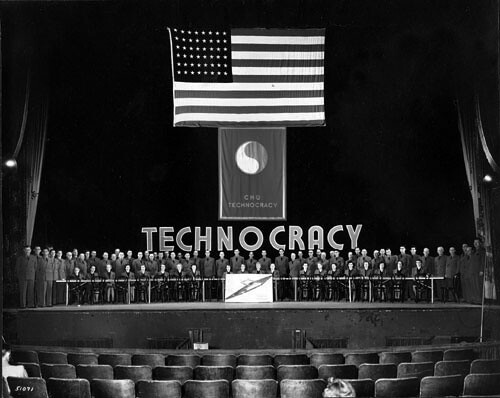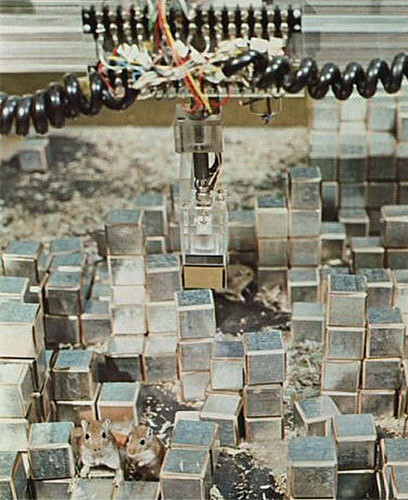In internet slang, 3DPD—meaning “three-dimensional pig disgusting”—is used to indicate that the 2D world is superior to the 3D world. The 3D world is lumpy. The friction from gravity and laws restricts individual freedom. There is the problem of having a body. And the light—the blizzard of photons coming from everywhere—is blinding and ugly. It is much more appealingly dark and smooth and pure to dematerialize into information and nurture faith in a digital platform. The internet is arguably a platform worthy of this kind of faith, but there are other platforms that aspire to parallel or even subsume the internet.
One of these, called ethereum, hopes to be the place for negotiating almost every kind of commercial, cultural, social, or legal exchange. In a video with a white-grey background and a centralized diamond-shaped logo, one of its founders, Vitalik Buterin, seems to barely need a body as he looks off-camera describing the ascendance of the platform towards Turing-complete universality.1 Having discovered the elementary particle upon which nearly every conceivable exchange might be built, ethereum proposes to replace centralized finance, social networking, law, and governance with a multitude of currencies, communication channels, individual contracts, and “decentralized autonomous organizations.” Encrypted against both security risk and interference from centralizing censorship, surveillance, or regulation, this massive platform for achieving “consensus” would make contracts into something like the new email.


Buterin acknowledges the persistent historical paradox immanent in all political organizations of the last ten thousand years—the desire for individual freedom versus the need for collective institutions. But he has the solution. Given that “a pure market has no way of paying for” large collective institutions, in an “economic democracy” one can simply choose from thousands of cryptocurrencies like Bitcoin, each of which is devoted to giving residual funds to a specific collective concern.2 The platform is actually a descendant of Bitcoin in that it also operates as a shared database, but ethereum ascends the organizational hierarchy to swallow Bitcoin, rendering it just another app or currency within its more comprehensive platform. Users may choose a currency that delivers funds to schools or another that funds health, or, its developers joke, a currency that funds mathematicians. What could possibly go wrong?
Ethereum is indebted to Bitcoin in another way as well. For a limited period of time in 2014, one could use Bitcoin to buy “ether”— an ethereum currency further subdivided into smaller denominations called the finney, szabo, shannon, babbage, lovelace, and wei.
Ether is a necessary element—a fuel—for operating the distributed application software platform we are building: ethereum. Without the requirement of payment of ether for every computational step and storage operation within the system, infinite loops or excessive storage demands could bog down ethereum and effectively destroy it.3
Buterin asks “what will you build on ethereum?,” characterizing it as a neutral plane on which the granular, consequential, and eventually liable constructions will be made. While the messier things will happen later, ethereum itself is as innocent and snowy white as its website and promotional videos, waiting to be freed, exempt from friction, and allowed to unfold on a pure plane providing “universality, simplicity, modularity, agility and non-discrimination.” In the “old one and the many” model, ethereum is “the one.”


Often the only history lessons the digital entrepreneur wants to hear are those that emphasize how important it is to win and get there first. Still, ethereum prompts a flashback to the Technocracy movement to which it bears at least a cartoon resemblance. Technocrats of the 1920s in several competing factions sought to replace political leaders with a “technate” of engineers who would be better suited to comprehensively collect data with which to rationalize the world’s production. The historical counterpart to the “ether” was the “erg,” an energy unit currency that would supplant the irrationalities of the price system. Costumed in grey uniforms and black neckties, Technocracy adherents gathered in great assemblies under a circular Technocracy logo. ethereum issues black T-shirts featuring an equally sober and elemental logo and a lowercase “ethereum.com” designed to signal the professed friendliness of open-source liberalism. Technocracy movement sentiments swung between idealistic desires for new, more just ways of managing global resources and clear ambitions for oiligarchic concentrations of authoritarian power. Similarly, as media curator and theorist Ben Vickers writes:
The embers of the 1990s rhetoric of cyberstates and pirate utopias are reigniting, signaled by an engineers’ call to arms for the wholesale transformation of systems of exchange, interaction, and governance. Yet these uncompromising visions of the future find themselves deeply embedded in the underbelly of Silicon Valley and, in particular, in an unholy trinity of anarcho-libertarian-capitalist technologies.4
Historically, the transcendent universal has often dramatized its anxiety about the threat of a lumpy world interfering with its special, exempt, and lubricated status. In an elite, accelerated lane towards perfection, universal dreams are disapproving of impurities that threaten to “bog down” the particular purity or freedom they had in mind. Yet, while the word “universal” wants to be singular, it is often plural. For instance, in the grips of early-twentieth-century modernist thinking, every science, art, or political entity flirted with universals of many different species, modeling for uniformity, homogeneity, modularity, spirituality, or immateriality. Given that each was taking off, sword drawn, in a different direction, collectively they may have created the heterogeneity they despised. But each persistently wished to be singular by supplanting the other. The feverish moderns swore allegiance, above all, to an avant-garde habit of mind that regarded intelligence as successive rather than coexistent; new ideas had to murder old ideas. Even more shrill or hysterical, the dramatic call to arms was used to inflame desires for totalizing political control.


Yet for all their sophistication, primitive organizational and temperamental dispositions often accompany dreams of a universal platform or ultimate technology. Many new platforms suggest that everything will be distributed, ad hoc, individualized and heterogeneous except their own one true monistic platform for exchange which will withdraw into a more transcendent plane of operations. And this essentially monistic disposition, often colored by liberal sentiments of many stripes, can assume a fiercely binary position against any challenger. The sense of a new technological platform as predestined to be the carrier of all of culture’s hope for advancement raises the stakes and sharpens the violence of its defense. Despite the potential of information-rich networks, these socio-technical organizations can then oscillate between monistic and binary dispositions that potentially erase or constrict information.
Apart from the content of any argument on any side, consider, as one example, only the temperamental dispositions of symmetrical face-offs between hackers and surveillance. Hackers now, quite rightly, assemble in large numbers with new purpose, standing up to preserve open as well a private exchanges. Surveillance takes a similar stance as victim and martyr as well as warrior. The disposition of the universal that each recognizes naturally becomes more monistic as both sides fortify against intrusion. Both begin to assume binary dispositions with escalating tensions. Both feel justified in spying on the other and encrypting against the other. Both claim violations of rights and freedoms. Both wish to withdraw into greater and greater realms of secrecy even as they retaliate with publicized attacks against each other that flaunt their airtight security or their technical savvy. In this oscillation between monistic and binary dispositions, each side is the control, and each side is the victim; each is offense, and each is defense. What is the dispositional shift that reduces violence in situations where violence itself threatens to restrict information?
Architecture, presumably trained to see the potentials immanent in organizational or structural strata, rarely focuses on these dispositional warning signs, and, picking up an old flag, typically marches to a familiar modernist story. Historically enthusiastic universalists and technocrats—ringleaders of modernist movements—they have argued for universal laws of proportion, modular systems, abstract formal languages, kits of parts, elemental forms, and redemptive technologies. And when the world resists this purity, they often withdraw into a more perfect, dematerialized, even spiritualized realm of drawing and speculation.


Architects still long to be modern like the old days. Having put faith in every successive new technology, believing in the obsolescence of the old and the superiority of the “new,” architecture easily flocks toward ubiquitous computing, smart cities, and the “internet of things.” Architects have embraced Kevin Kelly’s twentieth-century digital enthusiasm about cars as “chips with wheels,” airplanes as “chips with wings, farms as chips with soil, houses as chips with inhabitants.”5 OSARC (open source architecture) proposes a universal digital platform for the design and production of space in which, they argue, many of the modernists’ dreams can finally be realized. A new technology like Google Car will solve transportation problems. With something like Airbnb, we see tools to make architecture dance to immaterial instructions. New technologies will finally deliver the dematerialization of space into information. The whole world is Turing complete.
Yet, setting aside, even inverting, some default dispositions that attend universal, liberal, technocratic scripts, what previously obscured or sidelined information becomes available? What if there is no one and the many, but only the many? What if there is no quest for an elementary particle or a Turing-complete platform? What if there is no real desire for liberalism but rather a curiosity about maintaining individual rights through counterbalancing obligation—a fascination not with freedom but with friction? What if there is no primitive separation of mind and body? And might it become tedious to continually herd after another technology with calls for retooling and obsolescence? An alternative habit of mind would value the coexistence of multiple, counterbalancing, contradictory logics, looking not for the next superior subsuming platform but a disposition of interplay between different coexisting platforms of information. Might this ratcheting or reciprocal interplay enrich rather than restrict information?
For architecture this model of interplay potentially offers an especially powerful opportunity when space itself is regarded as a technology and an information system. Rather than instantly, characteristically converting to the next new technology to lead with digital variables, architecture can lead with spatial variables from a platform that tempers the digital at its moment of universal aspiration. Text and code are not the only mediums of information. Information is immanent in the relative positions and potentials of heavy, material spatial arrangements—in the physical matter, whether or not it is digitally enhanced. As cybernetician Gregory Bateson said, “information is a difference that makes a difference.”6 A man, a tree, and an ax, he noted, is an information system. Digital tools are not necessarily needed to make it space-dance and levitate. Given the right points of leverage, the exchanges between spatial variables are quite animated, even if they are only visible in time-lapse.
While architects and urbanists typically design object forms with shape and outline or master plans, sometimes more powerful than designing a thing is developing an interplay between things—active forms that serve as a platform for shaping a stream of objects or a population effect. These are time-released forms for which there can only be dynamic markers and partial control. They might engineer spatial consequence with the nonspatial or intangible variables, though these needn’t be digital to be intangible. They can even tune disposition or temperament in organizations—the undeclared or latent potential for productivity or violence in space. Rather than dematerializing into information, perhaps architecture and urbanism have special skills that materialize into information.
Making interplay in a material world calls on artistic faculties that exceed language, mathematical construct, scientific proof, bureaucratic consensus, ideology, or political declaration. These are faculties that are dispositional or less about “knowing that” and more about “knowing how”—a distinction that philosopher Gilbert Ryle used in his arguments against notions of a mind-body split. They often override intellection or rely on a mind that can model potentials in time. Comfortable with heterogeneity, this is correlative mind that knows how to translate between languages and ranges of information. It is a mind capable of working through a changing, unfinished process for which there can only be dynamic markers. It is a mind like that of a chess master except that the games cannot be rationalized and irrationalities must be modulated improvisationally. It is a mind where confidence games trump game theory—a mind that works with indeterminacy to be practical. One can only “know how” to navigate a river by observing ripples and dimples on the surface, correlate card combinations in poker against the changing faces of the players, feel for the potentials of bread in the dough, land a plane in high wind, sling plaster, hustle, kiss, or tell a joke.


There are architects who “know how.” They have mental faculties that allow them to walk over a field and subsequently draw its topographic map or predict the size of an upstairs bedroom in relation to an interest rate. Hyperaware of multiple levers and faders in urban space, they might think of changing a street by increasing the number of times a train stops there. They can mentally model the way a tax structure will eviscerate a city or the way a toxic building will topple all the buildings around it. Rather than a master plan for a city, they can design a growth protocol with a counterbalancing calculus of public and private space. They imagine collapsing the morphology of airports by reconceptualizing the departure lounge. They adjust the capacities of an entire highway network by altering the repertoire of one switch within it. They initiate a long-term process for organizing the forests and vantage points of a mountain range. They deliberately craft a seductive cultural story or persuasion to have explicit spatial consequences. They change suburban morphology by designing a detail that becomes contagious within a population of houses. Like the comedian who learned to tell jokes to keep his parents from fighting, an architect might even know how to deftly deploy a spatial variable to reduce the violence of binaries or dissipate monistic concentrations of authority—a spatial variable that might fly under the radar of political declaration.
The contemporary production of space intensifies the power of “knowing how” or the art of manipulating active forms within a spatial information system. Unfocusing to see not only buildings but also the almost infrastructural matrix space in which the building is suspended, it is clear that countless repeatable formulas and recipes make the most of the space in the world. Resorts, golf courses, malls, suburbs, retail, and now entire cities like free zones are designed as “spatial products.” Currently, McKinsey consultants, World Bank yes-men, financial quants, or management specialists make space as a by-product of econometrics or some other technical apparatus. Space is a secret weapon of the most powerful people on earth, but perhaps a secret best kept from the very people who are trained to make space. But an architect can hack the protocols of the most contagious spatial products. Active forms—things like multipliers, valves, governors, or switches—are the spatial equivalent of code for the heavy bulky world. Rather than object or declaration, they direct spatial processes as carriers of information. The more formulaic this matrix space, the more difficult it is to design object form, but the easier it is to design active form—to exploit the existing multipliers in the matrix with amplifying effects. This matrix that architects regard as the negative space or the unknowable opposite of object form offers not only new aesthetic pleasures but also new political capacities.
Inverting default assumptions, spatial variables frequently determine the shape and resilience of a digital network rather than the other way around. For instance, the Google Car has been widely regarded as the solution to a multitude of transportation issues. The new technology would allow cars to drive in perfect platoons increasing productivity while saving fuel. Yet, one simple but consequential piece of information often missing from these calculations is the size of the car. Automation would allow users to simulate the driverless convenience of mass transit. But when applied to the standard car it has the opposite of the desired effect. The sheer size of an increased number of cars creates a new form of congestion in the system that might negate all of the proposed gains in speed and efficiency. (The car service Uber has already simulated that effect by putting many more chauffered cars in the system.) Still, urbanists, even those who have long observed other false logics about traffic, are once again attracted to the new redemptive technology. Another solution might start with spatial variables, the sizes and capacities of different forms of transportation in a new interplay or a new set of spaces for switching—upshifting or downshifting between car and mass transit that makes both run more efficiently.
In the new technoscapes of countries like Kenya, large populations of cell phones are potentially changing everything—relationships to work, farm and market, tourism and wilderness. There are plenty of economists, McKinseyites, and bankers on the ground. Development expertise is spoken in languages of business, technology, informatics, and econometrics as it tries to predict the impact of broadband on development—what they call “Development 2.0.” There are plenty of new entrepreneurs writing software for billions of cell phones. Entrepreneurs know how to use the cell phone as a multiplier and a carrier of new relationships that have enormous spatial consequences. But the spatial consequences are treated as accidental byproducts of this software. No one is deliberately writing the protocols that start with space in the broadband technoscape. If the constant desired outcome of broadband urbanism is access to information, then the crucial information to access from digital networks is the information of the city. And the information of the city can enhance or constrict the capacities of the digital network. A time-released interplay of counterbalancing forces can protect the balance of power and resources in spaces. In Nairobi, for instance, free-zone incentives can be linked to much-needed transit, benefiting Nairobi while also delivering workers to business. Outside Nairobi, an active form might place broadband and roads in an interdependence. Dialing up broadband that attracts universities and tourism might result in dialing down roads that would disrupt the wilderness and indigenous culture—the information carried in space.


In the wake of the 2008 financial crisis in rustbelt cities and ghost suburbs across the US, the failure was so spectacular that many properties ceased to be mortage products. No longer standing for money, it was as if they returned to a gravitational field. Abandoned by financial institutions, they were adopted by land banks that trade in a parallel market of physical, material assets, reaggregating properties for use by cities and citizens. An architect who “knows how” might see a chance to not only put the development machine into forward but also put it into reverse. Active forms that direct the subtraction or contraction of development might be very useful in many parts of the world, from distended suburbs to coastal flood plains to sensitive environmental landscapes. These active forms lead with spatial variables that potentially stabilize by also offering more tangible risks and rewards than those offered by complex financial instruments or cryptocurrencies alone.
Every powerful spatial product in the world deploys active forms that are both organizational and narrative. The golf course suburb is a spatial software that puts into interplay things like the cost of fairway improvements with the surface area of the course, because the surface area has yielded enough housing lots to cover the debt. But this organizational active form is paired with a narrative form—like the sponsorship of a guru like Arnold Palmer or Jack Nicklaus. The narrative is like a rumor that enhances all the multipliers within the organization. A consistency between the story and the physical form is paramount to the precise soulful expression of the architect. But in matrix space, the most pervasive and powerful organizations are saying something different from what they are doing. Story and reality are decoupled. Not consistency but rather the ability to manipulate discrepancy is an indispensable skill in matrix space.
In the same way that spatial variables can confound the dominant systems of exchange with alternative markets and variables, they also offer a special kind of political stealth by carrying information not in declaration but in “undeclared” activity. This discrepancy between the declared and undeclared information carried in space challenges some customary approaches to political activism that rely on a righteous declaration of principles. Infrastructure space extends this customary repertoire to include the undeclared, the sneaky, and the evidence treated as inadmissible in master narratives of political theory. This auxiliary activist works on more than “knowing that”—more than knowing what to righteously oppose—to work on “knowing how” to oppose it. Uncertainty doesn’t preclude action. It is the stuff of a more finely grained and stealthy political world where one works with the indeterminate to be not only more practical but also more vigilant (than righteousness). This activist learns that through any combination of new technologies, new spatial softwares, or new persuasions, a snaking chain of moves can worm into an infrastructure space and gradually generate leverage against intractable politics.
Space is currently an underexploited medium of invention, governance, and stealthy or undeclared politics. While a new technology is often seen to repoliticize and rescue an existing technology like space, maybe the opposite is equally powerful. Maybe space, as an alternative platform, offers another kind of information that relieves technologies from the inherent tensions and violence of the universal default. Maybe, as undeclared process, space even offers a trapdoor out of the binaries that result from challenges to the universal in the same way that the least traceable “deep throat” communications are effective against the most intrusive digital surveillance. A habit of mind that values no single dominant platform but the interplay between them is more powerful still. Interplay offers no labels or objects to identify, but rather special skills for reading the practicalities of shaping dispositions with active forms. There is no way of knowing what to do but only how to do it. In addition to 3DPD, maybe there is a need for a variant of IRL (“in real life”)—something like IIRS or “information in real space.”
See →.
See → (20:30).
See →.
Ben Vickers, “The Year in Information: Secrets and Lies,” Artforum, December 2014, 298.
Kevin Kelly, New Rules for the New Economy (New York: Penguin Books, 1998), 76.
Gregory Bateson, Steps to an Ecology of Mind (Chicago: University of Chicago Press, 2000), 381, 462, 315, 272, 21.